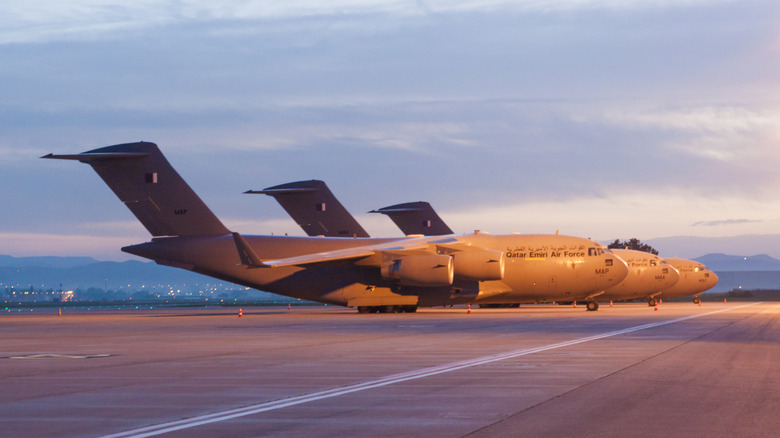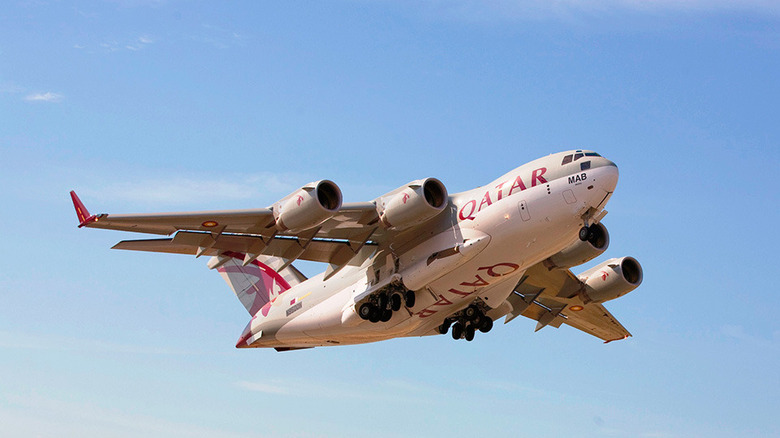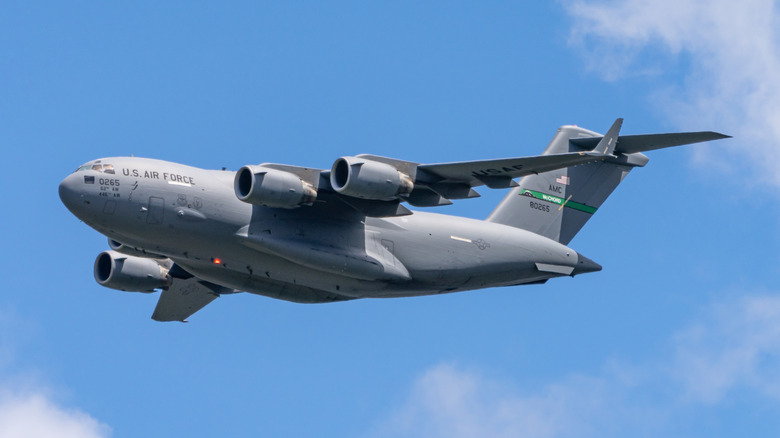Is Boeing Bringing Back The C-17 Globemaster?
In 2015, Boeing wrapped up production of the C-17 Globemaster III, one of the most iconic military transport aircraft ever made. The last C-17 took off from its production facility in Long Beach, California, on November 29 of that year and eventually joined the Qatari Air Force in early 2016, becoming the last of the four planes ordered by Qatar earlier that year. The C-17's production lasted well over two decades, with the first unit making its maiden flight in 1991. Boeing had made a total of 279 C-17s, of which 275 continue to remain in service as of 2025. Only one C-17 was lost in a 2010 accident that occurred near Elmendorf Air Force Base in Alaska, resulting in the deaths of four crew members.
Today, while Boeing continues to supply spare parts and offers technical support for all Boeing C-17 operators across the globe, the Long Beach manufacturing facility is long gone. It was dismantled and eventually sold to an Australian company for $200 million in 2019. Until as recently as 2023, Boeing had some C-17-related operations continuing in Long Beach. However, even those jobs were eventually moved out of the city.
Considering Boeing's entire ecosystem connected to the C-17 Globemaster was dismantled at its former manufacturing location, even the most optimistic C-17 fans have given up on a possible revival of the C-17 Program. However, much to everyone's surprise, just over a decade after the last C-17 was manufactured, Boeing is considering bringing the C-17 back to life.
The C-17 Globemaster comeback: Breaking down the rumors
During a Q&A session at the 2025 Paris Air Show, German military-focused publication ESD (European Security and Defence) spoke with Turbo Sjogren, vice president and general manager of International Government Services for Boeing Global Services. Given the current geopolitical scenario and the Russo-Ukrainian war, ESD asked the Boeing official about the problems faced by European forces in transporting large cargo — including main battle tanks and armored vehicles — due to the lack of suitably large aircraft. The question was whether Boeing was considering a new aircraft that would fulfill this role.
Turbo Sjogren's answer to this question surprised everyone.
While confirming that Boeing has no plans to invest in a new aircraft for this role, he went on to add that a number of countries had expressed interest in procuring the C-17, with one country, in particular, taking a keen interest in the plane. Without revealing the name of the country, Sjogren indicated that if there is enough demand from buyers and the economics make sense, the C-17 could, indeed, come back from the dead. He went on to add that these discussions are still in their infancy.
Following Sjogren's revelation, multiple news outlets reported the likelihood of the C-17 making an eventual comeback. The reality, however, is that even for a company as massive as Boeing, restarting the C-17 program is not an easy task. Let's investigate why.
The roadblocks to the Boeing C-17 Globemaster's comeback
The first major impediment to the C-17's comeback is the lack of a manufacturing facility. As outlined earlier, the massive 90-acre site where Boeing made the C-17s was sold a long time ago and no longer exists. Secondly, the machinery, equipment, and parts needed to manufacture airplanes are often custom-made. For example, the equipment and spare parts needed to manufacture a Boeing 787 Dreamliner would be significantly different from those required for the Boeing 737 Max. Getting the full array of custom-made tools for restarting the C-17 program could prove to be a logistical nightmare for Boeing.
Given that Boeing already dismantled and disposed of the old equipment needed to build the C-17 when it shuttered the program in 2015, getting them back is no longer an option. Even if Boeing had saved the equipment for later use, a decade of disuse would mean that many of them would need to be repaired, which, again, would become an expensive proposition.
A few years before the C-17 program was shuttered, RAND corporation — a nonprofit institution that performs research and analysis to improve policy and decision making – conducted a study on the expected cost that Boeing would have to incur to restart the C-17 production after a manufacturing pause. The figure it came up with was nearly $8 billion.
All things considered, it would take a massive order from multiple countries for Boeing to even think about restarting the C-17 program. What remains unclear is whether there's enough interest or confirmed demand from militaries worldwide for an updated C-17 Globemaster. If Boeing does secure a sizable number of orders, we might actually see new variants of the C-17 rolling out of a brand-new facility somewhere in the continental United States.


